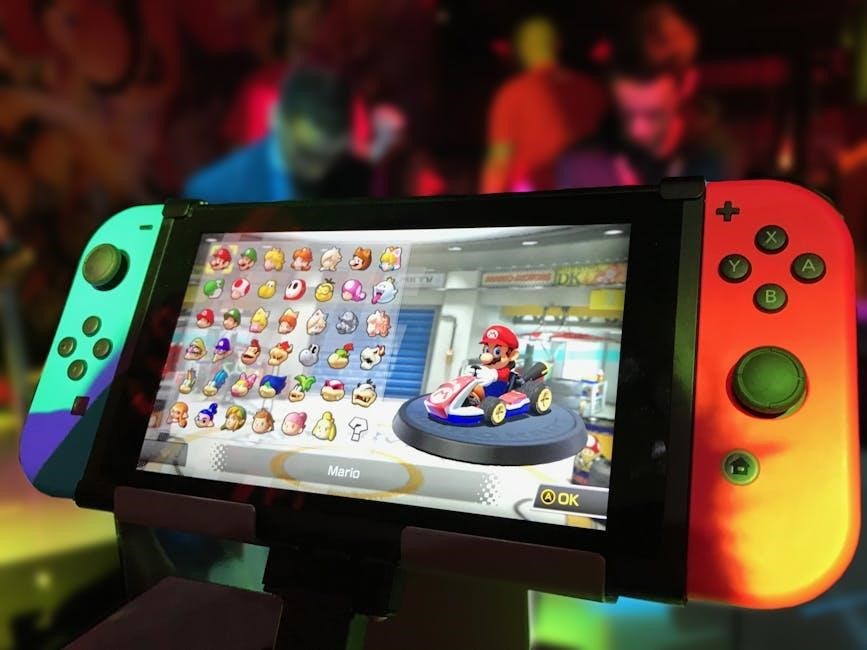Gateron switches have become increasingly popular in the mechanical keyboard community, lauded for their smoothness and affordability. These switches offer a diverse range of options, catering to various typing preferences and gaming needs. Their reputation for smooth keystrokes sets them apart.
What are Gateron Switches?
Gateron switches are mechanical keyboard switches known for their smooth and tactile typing experience. Often compared to Cherry MX switches, they offer a more affordable alternative without sacrificing quality. They are made from high-quality materials, ensuring durability and a lifespan of up to 50 million keystrokes.
Gateron produces three main types: linear, tactile, and clicky, each designed for a unique typing feel. Linear switches, like Red and Yellow, offer smooth, consistent keystrokes without a tactile bump, favored by gamers. Tactile switches, such as Brown, provide a noticeable bump, giving feedback upon actuation, ideal for typists. Clicky switches, like Blue, produce a distinct clicking sound, offering both tactile and auditory feedback.
Beyond the standard types, Gateron offers silent, ink, and other specialized switches. These are quickly becoming popular, catering to a wide range of preferences with various weights and actuation points. The switches are a great option for those seeking customization.

Types of Gateron Switches
Gateron switches come in various types, each offering a unique typing experience. These types include linear, tactile, and clicky switches, as well as silent and ink variations. Each category caters to different preferences and needs.
Linear Switches (Red, Yellow, Black, White)
Gateron linear switches are known for their smooth and consistent keystroke, lacking any tactile bump or audible click. This makes them a popular choice for gamers and typists who prefer a fluid and uninterrupted typing experience. The main line colors are not special.
Gateron Red switches are light with an actuation force of around 45g, making them ideal for fast-paced gaming. Yellow switches have a slightly heavier feel compared to Reds.
Black switches require more force to actuate, around 60g, providing a firmer feel. White switches have a lighter pressing force in comparison to others, fitting someone who types lightly.
These switches are similar in design, yet the departure strength differs, offering distinct typing experiences. The linear family provides a range of options based on preferred actuation force and feel.
Tactile Switches (Brown)
Gateron Brown switches are a popular tactile option, providing a noticeable bump when a key is pressed, offering feedback without the loud click of clicky switches. This tactile feedback is preferred by typists who want confirmation of keystroke registration without the noise.
With an actuation force of 45g, Gateron Brown switches strike a balance between responsiveness and resistance, making them suitable for both typing and gaming. The tactile bump is more obvious than some other tactile switches, providing a more distinct feel.
These switches are designed to offer a comfortable typing experience for those who prefer a tactile response. If you type a lot and like a tactile feel, go for the Gateron brown Switches.
Brown switches are versatile and can be used in a variety of settings, from office environments to home setups. The tactile bump provides a satisfying typing experience.
Clicky Switches (Blue, Green)
Gateron’s clicky switches, namely Blue and Green, deliver both tactile feedback and an audible click sound upon actuation. These switches are designed for users who enjoy a distinct and pronounced typing experience. The click sound provides auditory confirmation of each keystroke.
Gateron Blue switches typically require around 55g of actuation force, while Green switches are slightly heavier, demanding approximately 80g; This heavier actuation force of Green switches caters to users who prefer more resistance. These switches are not for everyone!
The Blue switches are very popular. The clicky sound and tactile bump are very good for people who like to hear and feel a distinct confirmation. However, the noise may not be suitable for quiet environments.
These switches are commonly used by typists who enjoy the old-school feel of mechanical keyboards. The clicky sound and tactile bump offer a satisfying typing experience, but can be loud.
Silent Switches
Gateron silent switches are engineered to minimize noise during operation, making them ideal for quiet environments. Unlike clicky switches that produce an audible click, silent switches utilize dampening mechanisms to reduce both the bottom-out and return sounds.
These switches are a popular choice for office environments, libraries, or shared living spaces. The reduced noise allows users to type without disturbing others. It is important to consider the environment that you are in. These switches can be used for home and work.
Gateron offers silent versions of several of their popular switch types, including silent reds, browns, and blacks. These silent variants retain the feel of their standard counterparts but with significantly reduced noise levels. The dampening is very good. They provide an excellent feel and are very quiet.
The silent switches are very popular and are known for their quietness.
Ink Switches
Gateron Ink switches represent a premium line of switches known for their unique housing and enhanced smoothness. These switches feature a smoky, transparent housing made from a distinct plastic material. The material gives them a smoother feel and a lower-pitched sound profile compared to standard Gateron switches.
The Ink series includes linear, tactile, and clicky options, each offering a refined typing experience. They are typically more expensive than standard Gateron switches. This is because of their superior materials and construction.
The lower pitch is something that many people want. It is much better than the Cherry MX switches. The Ink switches are often favored by enthusiasts seeking a premium feel and sound. The unique construction is what sets them apart from the other switches.
Gateron Ink switches offer a premium experience. The price is higher, but the quality is very good. The feel and sound are also very different. This helps to make them very popular.

Gateron Switch Comparison
Comparing Gateron switches involves understanding their unique characteristics, such as actuation force, travel distance, and sound profile. Gateron switches are frequently praised for their smoothness and cost-effectiveness compared to Cherry MX switches, providing users with diverse options.
Comparison with Cherry MX Switches
Gateron switches are often compared to Cherry MX switches, the latter having long dominated the mechanical keyboard market. Gateron switches are known for their smoother keystrokes due to a slightly smaller stem, offering a more enjoyable experience than some Cherry MX variants. This smoothness has become synonymous with Gateron switches;
While Cherry MX switches have commanded the market for a significant period, Gateron offers choices and embraces that smoothness. For example, Gateron’s white switch has a lighter pressing force compared to Cherry’s clear switch, making them a good fit for those who type lightly.
The regular Gateron switches are comparable to their Cherry MX counterparts, though some find them a cheaper, less durable option. Ultimately, the choice between Gateron and Cherry MX often comes down to personal preference and budget.
Linear Switch Comparison (Detailed)
Gateron offers a range of linear switches, each with unique characteristics. The linear switches are a smooth and quiet option without tactile feedback. There are six Gateron linear switches available, including Red, Yellow, Black, White, Cap Golden-Yellow, and Cap Milky-Yellow.
The Gateron Yellow switch has the same design as the Red but has a 5g greater departure strength. Gateron switches have an operation force range of 35gf to 80gf to accommodate various preferences. Many are unfamiliar with which Gateron linear switch they should pick.
Compared to Cherry MX switches, Gateron linear switches offer a smoother and more affordable option. For example, Gateron’s white switch has a lighter pressing force than the Cherry clear switch. Ultimately, the best linear switch depends on individual typing preferences and desired feel.
Gateron Pro vs. Gateron Pro 2.0
The Gateron Pro and Gateron Pro 2.0 switches represent advancements in the Gateron lineup. Since the release of the Gateron G Pro 2.0 Switch, it has become very popular with its smooth feel and backlight effect. There seem to be many people who are not very familiar with the G Pro 2.0 Switch yet, as it upgrades the mold.
The G Pro 2.0 switches are known for their enhanced smoothness and improved backlight diffusion. The difference between both the switches is the G Pro red switch has a bottom-out force of 70 gf, whereas the G Pro 2.0 red switch has a smaller bottom-out.
These upgrades contribute to a richer typing experience. Choosing between the two depends on individual preferences for specific tactile qualities and features. We will be comparing the Gateron G Pro 2.0 and the Gateron Pro switches.

Choosing the Right Gateron Switch
Selecting the right Gateron switch involves considering your preferred typing experience and intended use. Whether you prioritize tactile feedback, silent operation, or smooth linear action, Gateron offers a variety to suit your needs for the right switch type.
Factors to Consider (Typing Style, Gaming)
Choosing the ideal Gateron switch requires careful consideration of your typing style and gaming preferences. For typists, tactile switches like Browns offer a satisfying bump, providing feedback with each keystroke, aiding accuracy and reducing errors. Linear switches, such as Reds, provide a smoother, faster experience, ideal for speed typists who prioritize quick actuation and minimal resistance.
Gamers often prefer linear switches due to their responsiveness and rapid actuation, allowing for quick movements and repeated key presses. However, some gamers may prefer tactile switches for the added feedback and control. Silent switches are excellent for shared environments, minimizing noise without sacrificing performance. Ultimately, the best Gateron switch depends on individual preferences and priorities. Experimentation is key to finding the perfect match for your typing style or gaming needs.

Gateron Switch Lifespan
Regardless of the Gateron switch type, users can generally expect a lifespan of approximately 50 million keystrokes. This durability makes Gateron switches a reliable choice for both casual typists and dedicated gamers, ensuring longevity and consistent performance.
Durability (50 Million Keystrokes)
Gateron switches are engineered for long-lasting performance, boasting a rated lifespan of approximately 50 million keystrokes. This impressive durability ensures that the switches can withstand extensive use over prolonged periods, making them a reliable choice for both everyday typing and intense gaming sessions.
The 50 million keystroke lifespan is a testament to the quality of materials and construction employed in Gateron switches. This rating signifies the number of times a key can be pressed before it is likely to fail or experience degraded performance. It is important to note that this is an average, and actual lifespan may vary depending on usage patterns and environmental factors.
Whether you’re a programmer who spends hours coding, a writer crafting articles, or a gamer engaging in fast-paced action, Gateron switches are designed to endure the demands of your activities. This durability translates to a long-term investment, as you can expect your keyboard to maintain its responsiveness and tactile feel for years to come.
The robust construction of Gateron switches also contributes to their resistance to wear and tear. The internal components are designed to withstand repeated actuation, ensuring that the switches continue to function reliably even after millions of keystrokes. This makes Gateron switches a dependable choice for users who require a keyboard that can withstand heavy use.
